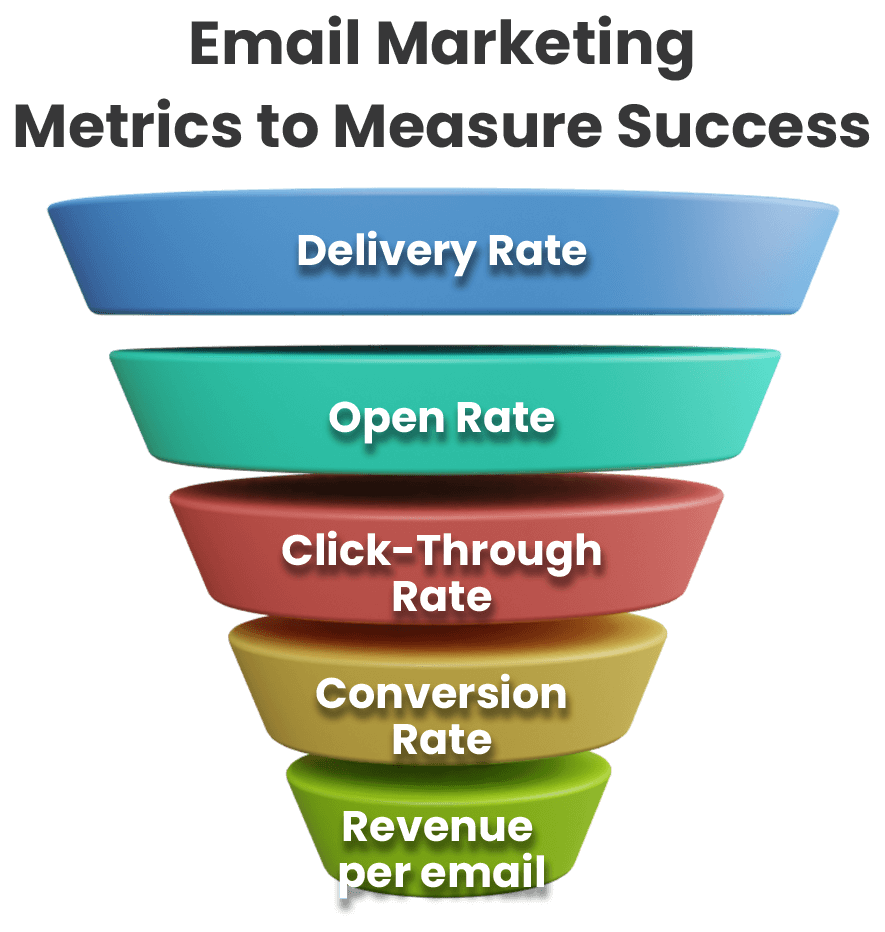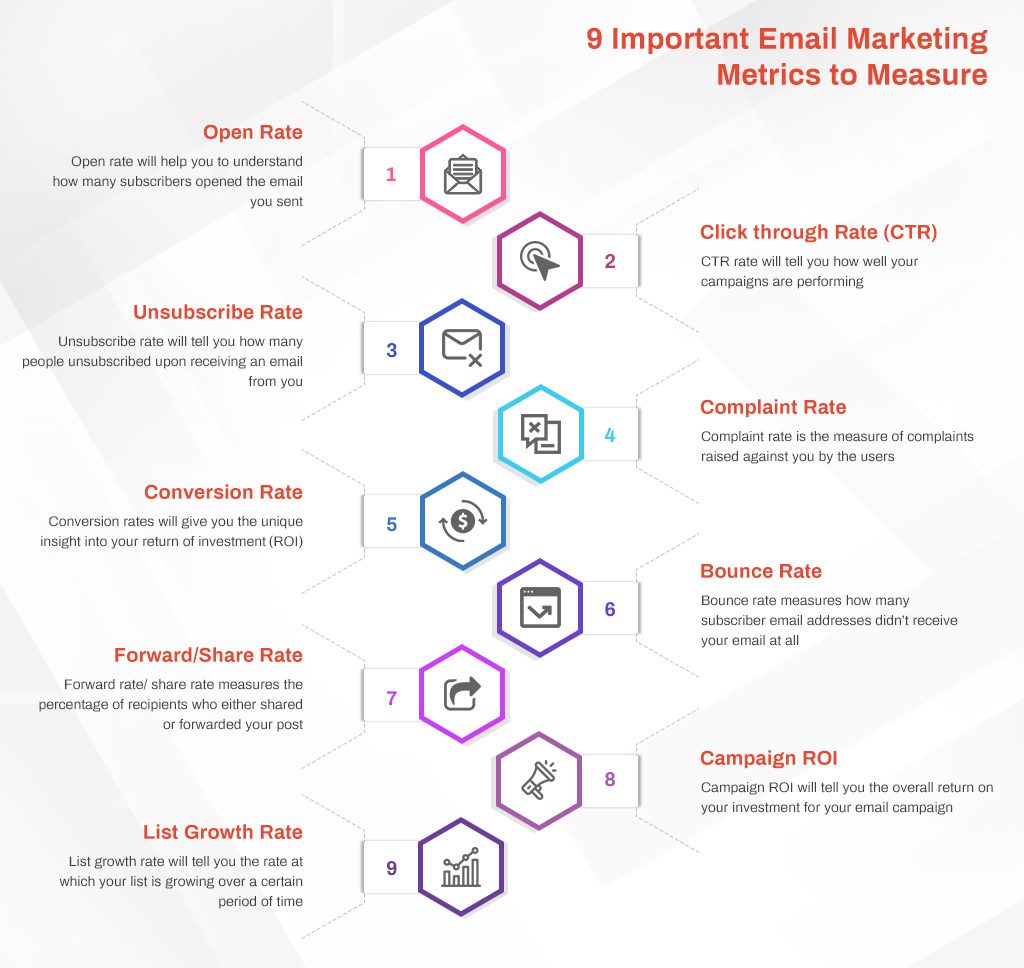Email marketing is vital for businesses. But how do you know if it’s working?
To measure email marketing success, you need to track specific metrics. These metrics can help you understand how well your email campaigns are performing. They reveal insights into open rates, click rates, and conversions. Understanding these metrics allows you to tweak your strategy for better results.
In this blog post, we’ll explore the key metrics you should monitor to measure your email marketing efforts. This will help you optimize your campaigns and achieve your marketing goals. Let’s dive in and see what metrics matter the most.
Open Rate
Email marketing is a powerful tool for businesses. To gauge its effectiveness, specific metrics are essential. One of the key metrics is the open rate. The open rate measures how many recipients open your emails. It provides insights into the success of your email campaigns.
Importance
The open rate is crucial for understanding engagement. A high open rate indicates that your subject lines are effective. It shows that recipients find your content interesting. This metric helps you improve your email strategies. It can lead to better customer relationships and increased sales.
Calculation
Calculating the open rate is straightforward. Divide the number of opened emails by the number of delivered emails. Then, multiply by 100. For example, if 100 emails are delivered and 25 are opened, the open rate is 25%. This simple formula provides valuable insights.
Click-through Rate
The Click-Through Rate (CTR) is a crucial metric in email marketing. It measures the effectiveness of your email content. CTR shows how many people clicked on a link in your email. A high CTR means your email content is engaging and relevant. Understanding and improving your CTR can boost your email marketing success.
Definition
Click-Through Rate (CTR) is a percentage. It represents the number of email recipients who clicked on one or more links in an email. To calculate CTR, divide the number of clicks by the number of delivered emails, then multiply by 100. For example, if you sent 1,000 emails and 50 people clicked a link, your CTR is 5%.
Improvement Tips
To improve your CTR, start with compelling subject lines. A good subject line grabs attention and encourages opens. Next, focus on your email content. Make it relevant and valuable to your audience. Use clear and concise language. Include a strong call-to-action (CTA). Ensure your CTA stands out and is easy to find.
Segment your email list. Send targeted content to different groups based on their interests. Personalization can also boost your CTR. Use the recipient’s name and tailor the content to their preferences. Test different elements of your emails. Experiment with subject lines, content, and CTAs to see what works best. Analyze the results and make data-driven decisions.
Optimize for mobile devices. Many people read emails on their phones. Ensure your emails are mobile-friendly. Use responsive design and keep your emails short and easy to read. Lastly, consider the timing of your emails. Send them at times when your audience is most likely to engage.
Conversion Rate
Conversion rate is a key metric in email marketing. It shows how many recipients take the desired action. This action could be making a purchase, signing up for a webinar, or downloading a resource. A high conversion rate means your email campaign is successful.
Tracking Conversions
First, track conversions to understand your email performance. Use tracking tools like Google Analytics. Set up specific goals for your campaign. These goals should align with your desired actions. Track each step of the user journey. This helps to see where users drop off. It also helps to improve your strategy.
Enhancing Conversion Rate
To enhance your conversion rate, start with your email content. Make sure it is clear and compelling. Use strong call-to-action (CTA) buttons. Place them where they are easy to find. Personalize your emails. This makes them more relevant to the reader.
Segment your email list. Group users by their behavior and preferences. Send targeted emails to each group. This increases the chances of conversion. Test different elements of your emails. Try different subject lines, images, and CTAs. See what works best and optimize accordingly.

Credit: www.litmus.com
Bounce Rate
Email marketing is a powerful tool for businesses. But, measuring its success is crucial. One key metric to watch is the bounce rate. The bounce rate shows how many emails failed to reach recipients’ inboxes. High bounce rates can harm your campaign. They also affect your sender reputation. Understanding bounce rate helps improve email delivery.
Types Of Bounces
There are two main types of bounces: hard bounces and soft bounces. Hard bounces happen when emails are sent to invalid or non-existent addresses. These emails will never be delivered. Soft bounces occur due to temporary issues. Full inboxes or server problems cause soft bounces. These emails might be delivered later.
Reducing Bounce Rate
To lower your bounce rate, start by cleaning your email list. Remove invalid or outdated addresses. Use double opt-in methods to confirm subscribers. This ensures your list is accurate. Regularly update your list to keep it fresh.
Also, monitor your email campaigns closely. Look for patterns in bounces. Identify and fix any issues causing high bounce rates. Use email verification tools to check addresses before sending. These steps help maintain a low bounce rate.
List Growth Rate
Email marketing is a powerful tool for businesses. One crucial metric to track is List Growth Rate. This metric shows how your email list is expanding over time. A growing list means more potential customers and increased brand reach. Let’s dive deeper into how to measure and improve your List Growth Rate.
Growth Measurement
To measure List Growth Rate, start by counting your new subscribers. Next, subtract any lost subscribers. Finally, divide this number by the total number of subscribers at the start. Multiply by 100 to get the percentage.
For example, if you started with 1,000 subscribers, gained 200, and lost 50, the calculation is:
(200 – 50) / 1000 100 = 15%
This means your list grew by 15% over the period.
Strategies For Growth
Offer incentives for new subscribers. Discounts, free trials, or exclusive content work well. Promote your email list on social media. Use clear calls-to-action on your website. Guest blog on other sites and include a signup link. Consistently deliver valuable content to keep subscribers engaged.
Focus on these strategies to see steady list growth over time.
Unsubscribe Rate
The unsubscribe rate is a crucial metric in email marketing. It indicates the percentage of recipients who opt out of your mailing list after receiving an email. A high unsubscribe rate can signal problems with your email campaigns. Understanding what causes unsubscribes and how to lower this rate is essential for a successful email marketing strategy.
Causes Of Unsubscribes
Understanding the reasons behind unsubscribes can help you improve your email campaigns. Common causes include:
- Irrelevant Content: Recipients may unsubscribe if the content does not meet their expectations or interests.
- Too Frequent Emails: Sending emails too often can overwhelm your audience, causing them to opt out.
- Poor Email Design: Emails that are hard to read or navigate can frustrate recipients.
- Spammy Appearance: If your emails look like spam, recipients are more likely to unsubscribe.
Lowering Unsubscribe Rate
Reducing the unsubscribe rate can improve your email marketing effectiveness. Here are some strategies:
- Segment Your Audience: Group your email list based on interests and behaviors. Send targeted content that resonates with each segment.
- Optimize Email Frequency: Test different sending frequencies to find the optimal balance for your audience.
- Enhance Email Design: Ensure your emails are mobile-friendly, visually appealing, and easy to read.
- Provide Value: Offer valuable content and exclusive offers that make recipients want to stay subscribed.
Tracking the unsubscribe rate and taking steps to address the causes can lead to more engaged subscribers and more successful email campaigns.
Email Sharing/forwarding Rate
Email marketing metrics are crucial to understanding the success of your campaigns. One important metric is the Email Sharing/Forwarding Rate. This metric shows how often your emails are shared or forwarded by recipients. It helps you gauge the virality of your content and its reach beyond your initial email list.
Why It Matters
Tracking the Email Sharing/Forwarding Rate is essential. It indicates how engaging your content is. When recipients share your emails, it means your message resonates with them. This can lead to increased brand awareness and potential new subscribers.
A high sharing rate means your content has value. It encourages recipients to share it with others. This can expand your email list organically. Plus, it can boost your brand’s credibility.
Encouraging Sharing
To increase the Email Sharing/Forwarding Rate, create engaging and shareable content. Here are some tips:
- Use clear and compelling subject lines.
- Include valuable and relevant information.
- Add social sharing buttons in your emails.
- Encourage recipients to share with friends and colleagues.
- Offer incentives for sharing, such as discounts or exclusive content.
Make it easy for recipients to share your content. Simple calls-to-action can be very effective. For example, include a line like “Share this with someone who might benefit.”
Monitor your Email Sharing/Forwarding Rate regularly. Adjust your content and strategies based on the data. This will help you improve your email marketing efforts over time.

Credit: blog.aweber.com
Roi Calculation
Calculating the return on investment (ROI) for email marketing is crucial. It helps marketers understand the effectiveness of their campaigns. By measuring ROI, businesses can determine the value generated from their email marketing efforts.
Determining Roi
To determine ROI, start by identifying your total revenue from email campaigns. Next, subtract the total cost of your email marketing activities from this revenue. Divide this result by the total cost of the email marketing activities. Finally, multiply by 100 to get the ROI percentage.
For example, if your revenue is $10,000 and your costs are $2,000, the calculation is: ($10,000 – $2,000) / $2,000 100. This gives an ROI of 400%. This metric shows how much profit was made for each dollar spent.
Maximizing Roi
To maximize ROI, focus on improving the quality of your email list. Ensure your emails are targeted and relevant to your audience. Personalized content often leads to higher engagement and conversion rates.
Monitor key performance indicators like open rates, click-through rates, and conversion rates. These metrics provide insights into what works and what needs adjustment. A/B testing different email elements can also help refine your strategy. Experiment with subject lines, content, and sending times.
Utilize automation tools to streamline your email marketing processes. Automated workflows can save time and increase efficiency. This allows you to focus on crafting compelling content and building relationships with your audience.

Credit: clearout.io
Frequently Asked Questions
What Are The Key Email Marketing Metrics?
Key email marketing metrics include open rate, click-through rate, conversion rate, bounce rate, and unsubscribe rate. These metrics help you understand the effectiveness of your campaigns and audience engagement.
How To Measure Email Marketing Success?
To measure email marketing success, analyze metrics like open rate, click-through rate, conversion rate, and ROI. These indicators show how well your emails perform and their impact on your goals.
Why Is Open Rate Important?
Open rate is important because it shows how many recipients opened your email. A high open rate indicates strong subject lines and effective targeting, leading to better engagement.
What Is Click-through Rate?
Click-through rate (CTR) measures the percentage of recipients who clicked on a link in your email. It helps gauge the effectiveness of your content and call-to-action.
Conclusion
Measuring email marketing success is crucial. Track open rates and click-through rates. Monitor conversion rates and unsubscribe rates. Analyze your email list growth. Use these metrics to improve. Regular checks help refine your strategy. Make data-driven decisions for better outcomes.
Keep your audience engaged and informed. Effective tracking leads to successful campaigns. Start measuring today for greater insights.


Leave a Reply